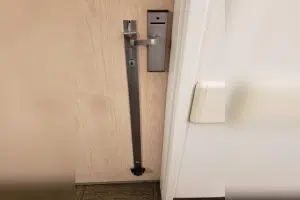Before COVID-19 was a known term across the world, Randy Janes hated the idea of touching any doorknob at any restaurant or gas station he went to.
Now with the added emphasis on germ-free environments to limit the spread of the coronavirus, Janes sees the problem an average doorknob or handle presents daily as the owner of Wave of the Future 3D.
“I do get people, I’ll watch them walk up, they’ll stop, they’ll pause, they’ll figure out what part of their shirt they’re going to open the door with, or their cuff, or if they’re going to let someone else open it for them,” Janes said.
“People didn’t like to touch them before and now they just don’t like to touch them.”
So Janes and his crew at Wave of the Future are 3D-printing solutions to the problem a public-facing door presents.
Called the SafeZone, Janes is using a battery-powered UVC light to create a device that locks on to a door handle and uses motion sensors to turn the light on once a person lets go of the doorknob. By the time the door swings close, the light has sanitized the doorknob for the next person.
“There’s no risk of hurting anybody when you hear of UVC lights and how they’re harmful to the skin,” Janes said of his new creation. “The sensors are to make sure that everybody is safe and away when the light turns on. Then, if you jump in between (sequences), it will sense motion and light and turn off again.”
Battery life is expected to last three to six months depending on temperature sensitivity if the device is attached on the inside or outside of the building. Batteries can then be easily swapped out for little maintenance.
Janes also has an adhesive plate that’s used for turning door handles. Using a person’s foot to apply a little pressure to the bottom of the plate, the bar will slide down and move the handle down to ensure a handsfree doorway.

The SafeZone for door handles uses a peel-and-stick plate with a foot grip at the bottom to utilize the UVC technology for even more doorways. (Keenan Sorokan/650 CKOM)
With the versatility of 3D printing, Janes is able to retrofit the device for a variety of uses, like transit systems, school buses and beyond.
To garner interest in the new devices, Janes is launching a Kickstarter campaign on Tuesday with hopes of securing $300,000 in preorder purchases.
“It’s more or less putting a product on the market to see what the world thinks of it, and also they back the product,” Janes said.
Money from the Kickstarter campaign will be used to add components to SafeZone, like longer-lasting batteries.
Janes has also patented handrails, wall rails, airport barriers and dividers that will use more of a far-ranging UVC light to sanitize surfaces from a distance.
“We’re just trying to keep the doors open and move forward,” Janes said. “Now with this product, we just want the world out there to know that there’s a product that can get you in and out of doors a lot safer.”











